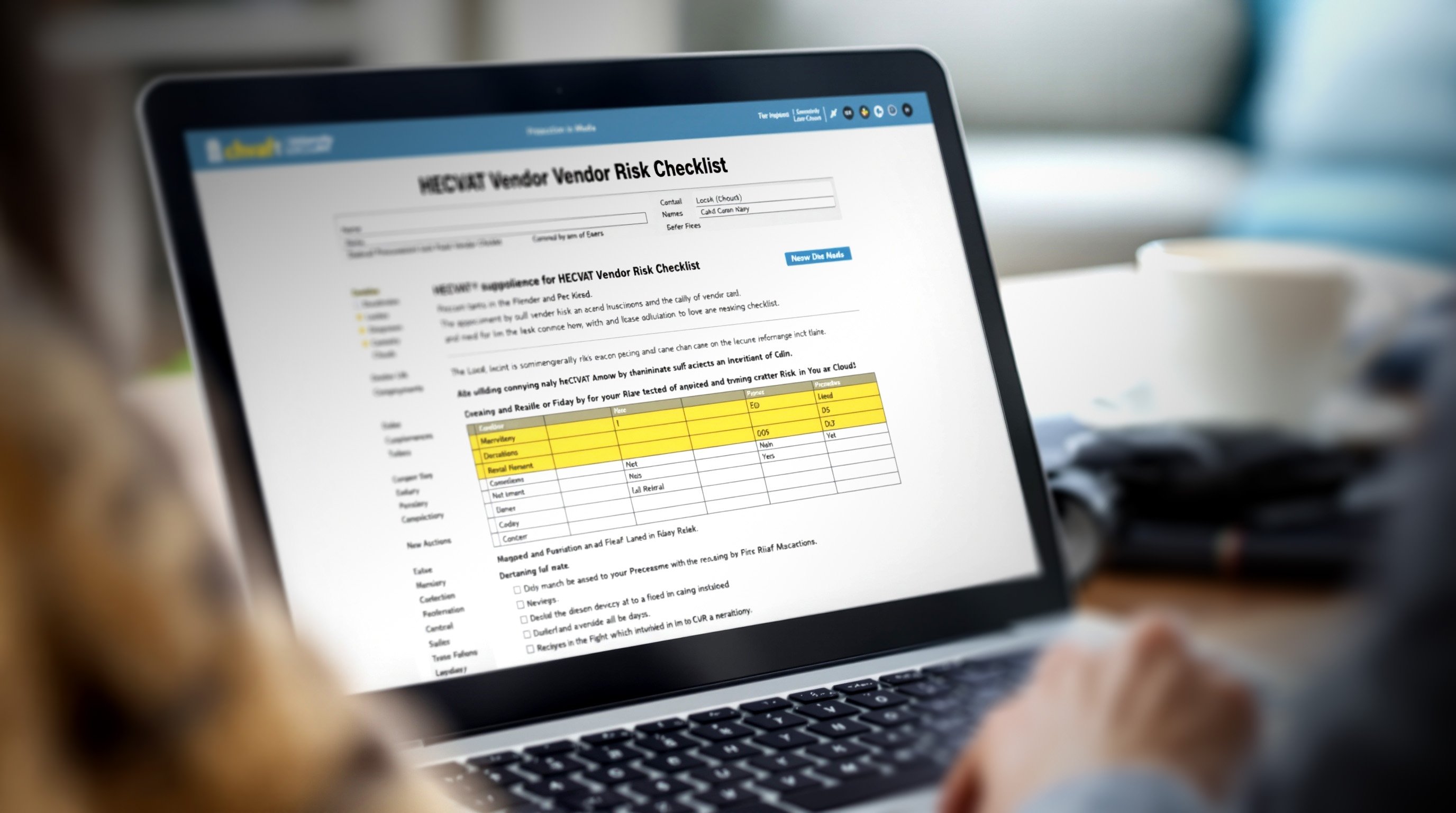HECVAT for EDU Marketers
HECVAT
The Higher Education Community Vendor Assessment Toolkit (HECVAT) is a security questionnaire colleges use to assess vendor risk. It has increasingly become a standard vendor qualification requirement in higher education.
Developed collaboratively by EDUCAUSE, Internet2, and the Research and Education Networks Information Sharing and Analysis Center (REN-ISAC), HECVAT provides a common framework for vendor security assessments.
HECVAT 4 launched in early 2025 with new AI-specific questions that impact marketing vendors. Lead scoring algorithms, enrollment chatbots, and personalization tools now require detailed governance documentation.
HECVAT operates alongside marketing compliance requirements such as TCPA, FERPA, and state privacy laws, creating additional compliance layers for vendors.
Who Requires HECVAT
HECVAT is required for vendors handling student data, providing cloud services, or accessing campus networks. Marketing agencies, lead generation companies, CRM providers, and marketing automation platforms fall under these requirements.
Procurement departments integrate HECVAT into vendor qualification processes. IT security teams use the assessment to evaluate risk before approving contracts. Some institutions require annual updates from existing vendors.
The requirement extends beyond direct contracts. Subcontractors and agency partners may need assessments if they access institutional systems or handle student information.
More and more top universities are using HECVAT to assess vendor risk across their technology procurement decisions.
Why HECVAT 4 Matters for Marketing Teams
HECVAT 4 now covers the marketing systems that collect or process student and prospect data. That includes ad platforms, web forms, CRMs, chatbots, and analytics tools. If a system tracks visitors, stores contact information, or uses AI for targeting or personalization, universities will review it for security and privacy risk.
Reviewers want to know exactly how data moves through your stack—what you collect, where it goes, how long you keep it, and whether any AI tools learn from it. They also expect written policies showing who has access and how that access is controlled.
For marketing teams, this makes HECVAT more than a compliance task. It’s part of how you prove institutional trust. A clean, current HECVAT shortens procurement, avoids contract delays, and gives security teams fewer reasons to hold up your campaign launch.
In higher education, being “HECVAT-ready” is becoming table stakes. It shows that your marketing operation treats student data with the same rigor as IT—something campuses now expect from every vendor that touches enrollment data.
HECVAT and FERPA
HECVAT supports a university’s obligation under the Family Educational Rights and Privacy Act (FERPA). FERPA allows institutions to share student data with outside vendors only when those vendors act as “school officials.” To qualify, the vendor must perform a service for the institution, operate under its direct control, use data only for authorized purposes, and prevent unauthorized re-disclosure.
HECVAT gives universities the evidence to prove those conditions. It documents how a vendor protects data, who has access, how information is shared, and what controls exist for deletion or incident response. For marketing vendors, that includes details about form submissions, tracking systems, CRMs, and contact center operations.
When a school names you as a “school official,” it is effectively extending its FERPA responsibilities to you. That makes your security and privacy controls part of their compliance posture. A current HECVAT shows that you can meet those standards and gives procurement and legal teams confidence to proceed.
In practical terms, aligning your operations with FERPA means maintaining named user accounts, enforcing least-privilege access, documenting data flows, and providing a fast way to revoke access if a contract ends. Those same measures also strengthen your HECVAT response and make future reviews simpler.
How to Prepare a HECVAT Package
A strong HECVAT response shows how your organization manages data in practice. Reviewers want proof that your security and privacy controls are in place and working. The clearer that evidence is, the faster reviews move.
Start with the current HECVAT 4 workbook. Complete the sections that apply to your service and provide specific, accurate answers. If you use subcontractors or third-party platforms, identify them and describe how they handle data.
Add a data flow diagram that shows what data you collect, where it goes, and who can access it. This gives reviewers a simple way to confirm your data boundaries.
Include short excerpts from key policies and procedures, such as:
-
Access control and authentication
-
Data retention and deletion
-
Incident response and breach notification
-
AI and privacy governance
Attach a sub-processor list naming any vendors who handle institutional or prospect data on your behalf. Note their location and link to their compliance documentation when possible.
If your systems use AI or machine learning, include an AI policy statement confirming that institutional data is not used for model training without explicit consent.
Keeping these materials organized and up to date shows that your team has defined processes for data handling. That documentation helps campus reviewers verify compliance and complete their evaluations more efficiently.
How to Share Your HECVAT Materials
HECVAT materials include detailed information about your security and privacy controls, so they should be shared privately. Most universities request them under a nondisclosure agreement or through their procurement portal.
If you want to show your readiness publicly, the Internet2 Cloud Scorecard is the primary community directory for higher education vendors. It lets you post a short security profile that signals to campuses that your organization follows established standards. The full HECVAT workbook and supporting evidence should remain available only on request.
You can also link to your cloud provider’s compliance documentation (for example, AWS, Azure, or Google Cloud) to verify inherited certifications such as SOC 2 or ISO 27001. SOC 2 is an independent audit of how an organization protects customer data, while ISO 27001 defines international standards for managing information security. Linking to these reports helps reviewers confirm your platform’s baseline controls without extra paperwork.
Keep a dated copy of your HECVAT package stored securely and update it each year. Having a current version ready allows your team to respond quickly when campuses ask for documentation during procurement or renewal.
Maintaining HECVAT Readiness
HECVAT is not a one-time exercise. Each new campaign, integration, or feature that changes how data moves can alter your risk profile. Treat your documentation as part of your operational workflow, not as a compliance snapshot.
Keep one person or team responsible for maintaining the HECVAT workbook and related evidence. Update it whenever your system architecture, subprocessors, or policies change. An annual review cycle works for most vendors, but faster updates are needed when new tools or AI functions are added.
Version control matters. Store your workbook and attachments in a secure shared location with clear naming conventions and dates. That makes it easier to prove continuous compliance when a campus requests your latest version.
Finally, use your HECVAT package internally. It can help train staff, align marketing and IT on data practices, and identify weak spots before a buyer does. When treated as a living document, it becomes both a security record and a sales asset.
HECVAT FAQ
What is HECVAT used for?
HECVAT helps colleges and universities evaluate how vendors manage data security, privacy, and risk. It gives campus IT and procurement teams a consistent way to verify that a vendor meets institutional requirements before signing a contract.
Who needs to complete HECVAT?
Any vendor that handles student or prospect data, provides cloud-based services, or integrates with campus systems may be asked to complete it. This increasingly includes marketing agencies, enrollment platforms, and CRM providers.
How often should HECVAT be updated?
At minimum, once a year. You should also update it whenever new systems, subprocessors, or AI features change how data is handled.
Is HECVAT mandatory?
There is no national requirement, but many universities make it a condition of procurement. Completing it early often speeds review and builds trust with institutional buyers.
How detailed should responses be?
Be specific and verifiable. General statements about “industry best practices” are not enough. Link each control or policy to real documentation or process evidence.
Can HECVAT replace other security certifications?
No. It complements standards such as SOC 2 or ISO 27001. Those certifications can support your HECVAT answers, but institutions still require the workbook for consistency across vendors.
HECVAT has evolved from a security checklist into a trust framework that shapes how universities choose their partners. For marketing and enrollment vendors, being prepared is no longer optional. Treat your HECVAT materials as part of your sales and compliance strategy, keep them current, and use them to show that your organization handles student data responsibly.
Together, HECVAT and FERPA form the foundation of data-trust compliance in higher education marketing.
Learn more about Education Marketing Regulations or General Marketing Compliance
References
-
-
California State University, Long Beach (CSULB): Vendor Security Assessment (HECVAT)
-
University of Notre Dame: HECVAT Process for Third-Party Vendors
- AWS Public Sector Blog: Higher Education Community Vendor Assessment Toolkit Now Available on AWS Artifact (Feb 2025)
-
U.S. Department of Education: Protecting Student Privacy (FERPA)






